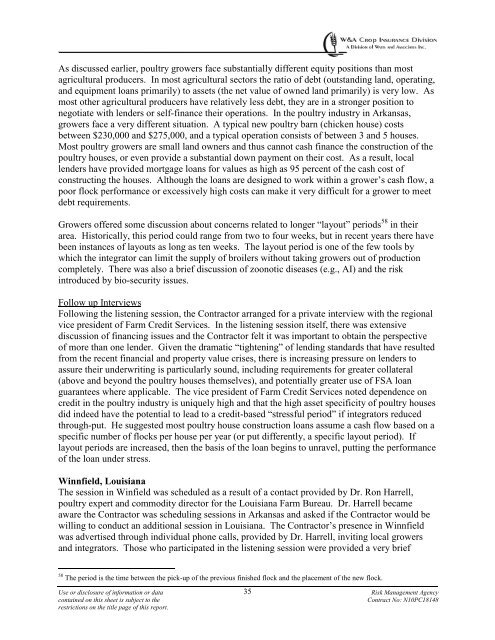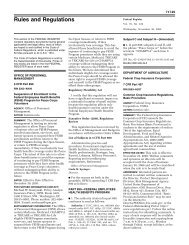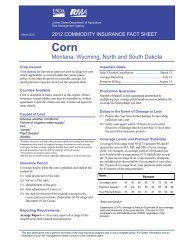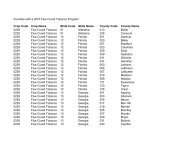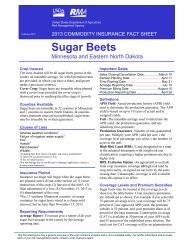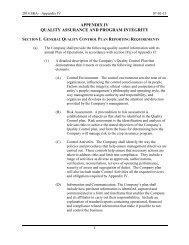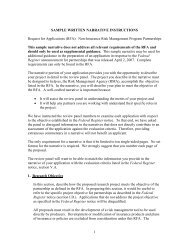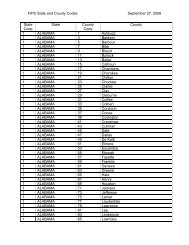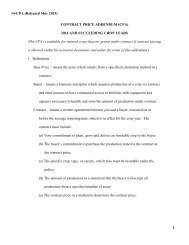Feasibility research report for insuring commercial poultry production
Feasibility research report for insuring commercial poultry production
Feasibility research report for insuring commercial poultry production
Create successful ePaper yourself
Turn your PDF publications into a flip-book with our unique Google optimized e-Paper software.
As discussed earlier, <strong>poultry</strong> growers face substantially different equity positions than mostagricultural producers. In most agricultural sectors the ratio of debt (outstanding land, operating,and equipment loans primarily) to assets (the net value of owned land primarily) is very low. Asmost other agricultural producers have relatively less debt, they are in a stronger position tonegotiate with lenders or self-finance their operations. In the <strong>poultry</strong> industry in Arkansas,growers face a very different situation. A typical new <strong>poultry</strong> barn (chicken house) costsbetween $230,000 and $275,000, and a typical operation consists of between 3 and 5 houses.Most <strong>poultry</strong> growers are small land owners and thus cannot cash finance the construction of the<strong>poultry</strong> houses, or even provide a substantial down payment on their cost. As a result, locallenders have provided mortgage loans <strong>for</strong> values as high as 95 percent of the cash cost ofconstructing the houses. Although the loans are designed to work within a grower‘s cash flow, apoor flock per<strong>for</strong>mance or excessively high costs can make it very difficult <strong>for</strong> a grower to meetdebt requirements.Growers offered some discussion about concerns related to longer ―layout‖ periods 58 in theirarea. Historically, this period could range from two to four weeks, but in recent years there havebeen instances of layouts as long as ten weeks. The layout period is one of the few tools bywhich the integrator can limit the supply of broilers without taking growers out of <strong>production</strong>completely. There was also a brief discussion of zoonotic diseases (e.g., AI) and the riskintroduced by bio-security issues.Follow up InterviewsFollowing the listening session, the Contractor arranged <strong>for</strong> a private interview with the regionalvice president of Farm Credit Services. In the listening session itself, there was extensivediscussion of financing issues and the Contractor felt it was important to obtain the perspectiveof more than one lender. Given the dramatic ―tightening‖ of lending standards that have resultedfrom the recent financial and property value crises, there is increasing pressure on lenders toassure their underwriting is particularly sound, including requirements <strong>for</strong> greater collateral(above and beyond the <strong>poultry</strong> houses themselves), and potentially greater use of FSA loanguarantees where applicable. The vice president of Farm Credit Services noted dependence oncredit in the <strong>poultry</strong> industry is uniquely high and that the high asset specificity of <strong>poultry</strong> housesdid indeed have the potential to lead to a credit-based ―stressful period‖ if integrators reducedthrough-put. He suggested most <strong>poultry</strong> house construction loans assume a cash flow based on aspecific number of flocks per house per year (or put differently, a specific layout period). Iflayout periods are increased, then the basis of the loan begins to unravel, putting the per<strong>for</strong>manceof the loan under stress.Winnfield, LouisianaThe session in Winfield was scheduled as a result of a contact provided by Dr. Ron Harrell,<strong>poultry</strong> expert and commodity director <strong>for</strong> the Louisiana Farm Bureau. Dr. Harrell becameaware the Contractor was scheduling sessions in Arkansas and asked if the Contractor would bewilling to conduct an additional session in Louisiana. The Contractor‘s presence in Winnfieldwas advertised through individual phone calls, provided by Dr. Harrell, inviting local growersand integrators. Those who participated in the listening session were provided a very brief58 The period is the time between the pick-up of the previous finished flock and the placement of the new flock.Use or disclosure of in<strong>for</strong>mation or datacontained on this sheet is subject to therestrictions on the title page of this <strong>report</strong>.35Risk Management AgencyContract No: N10PC18148


